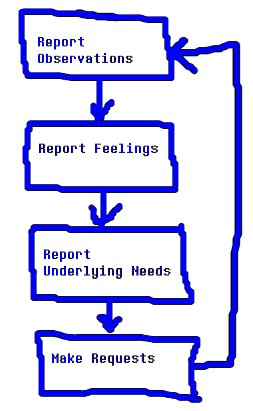Internal Family Systems really pushes Unblending as the one way to heal your Parts. It can work well for some people, but it’s not always the best option for me. I’ve found other approaches that work fairly well in cases where unblending isn’t a great option.
Part to Part
Parts work is supposed to be done from Self, but it can be done between parts as a team if you have parts that are willing to mediate or give the benefit of the doubt. This can be especially effective for resolving conflicts between two parts with a third part acting as mediator, or for pairing a young part with an older mentor or parent.
I’ve found that the most important aspect of working from a blended part is which part does the work. Parts can work on themselves pretty effectively while blended, but resolving a conflict between two parts seems to work best with the third mediator part being blended more than any part directly involved in the conflict.
It’s also possible to do slower work in a shared journal or binder. Instead of doing the work inside of your head, you can do it on paper, letting parts pitch in when blended. It’s a bit harder to predict which parts will be involved, but it can let a conversation happen between parts that may not be able to easily reach each other otherwise. It also takes out some of the bite from an argument by creating a gap in time between responses, making it good for mediating situations where most or all parts have strong opinions. (The key is agreeing to let every part say what they want to say; no censoring each other!)
It’s MUCH harder to unburden parts this way. It can be done, but expect it to take a long time and a lot of coping skills. You’re letting your parts feel and express the pain of the past (without rejecting or avoiding it!) and let it go while also helping them stay grounded in the present and avoiding upsetting the protectors who worked all this time to keep that exact pain from being felt. It is ridiculously, stupidly hard to do this without outside help to remind you that you’re watching this happen in the present instead of re-experiencing it. There’s a good reason IFS focuses so hard on doing this work from the stable position of Self.
Seriously. If you have any choice in the matter, do your unburdening from Self and use blended work to explore and improve trust between parts instead.
More blending as balancer
Sometimes, unblending is suggested as a way of finding balance or getting distance from a part’s opinions.
Instead of unblending, try the following:
- Ask if there are any parts that disagree with the one most present at the moment, or that have additional context to add.
- If there are, then ask those parts to come forward and join them (or sit side-by-side, or otherwise share Presence with them).
- If needed, ask if there are any parts willing to mediate between the present parts. Ask them to come forward as well.
But what if they fight?
This does take some practice. If parts with polar opposite opinions or mutual dislike share space, then they may argue, which makes it harder to get any work done. A mediating part or outside party (e.g. therapist, trusted friend) can help resolve this argument by working through the conflict directly. If your mediator is another part, then it seems to be most effective when the mediator part is the most present / connected to consciousness of the group in my experience. Tactics used for teaching conflict resolution in couple’s counseling also seem to be helpful here.
Alternatively, you can allow parts to come forward to do work only when they’re willing to disagree respectfully instead of arguing. Agreeing to a baseline level of respect makes it much easier to work through issues together.
If you lack experience with peaceful conflict, then seeking out positive examples helps considerably with learning how to disagree with each other without exploding over it. Don’t go looking for drama movies when doing this. Look for educational videos or books that model healthy relationships and learn from those. Also look into “I statements” and nonviolent communication strategies.

(Image by Ziz, taken from an archive of False Faces.